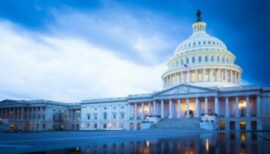Inland Waterways
Startup Uses Drone for Cleaning Water, Collecting Data

Alaskans think about infrastructure a little bit differently than the rest of the United States. Alaska’s infrastructure is truly unique, covering a vast area of over 663,000 square miles and supporting a population of just over 730,000. For transportation systems, there is no one mode of transport in Alaska, and sometimes the route is different depending on the time of year. Some homes do not have access to indoor plumbing, and while sometimes that’s by choice, too often it’s not. Many of Alaska’s remote communities are still in need of water and wastewater systems that are safe, efficient, and sustainable, while even our most populated areas are still learning how best to handle every day solid waste in a subarctic environment.
Alaska’s infrastructure investment is crucial to our way of life and success of the economy. Historic investment at the federal level through the Infrastructure Investment and Jobs Act creates a similarly historic opportunity for state and local levels to maximize the benefits of Alaska’s infrastructure investment to last for generations to come. As Alaska legislators address budget challenges, the Alaska Report Card – developed for Alaska, by Alaskans – demonstrates the importance of continued infrastructure investment.
There are solutions to raise Alaska’s infrastructure grades! Together with the information provided in the Report Card for Alaska’s Infrastructure, it is ASCE Alaska Section’s hope that Alaska’s Civil Engineers can work together with state leaders to plan, design, build, operate and maintain safe, efficient and sustainable infrastructure for all Alaskans.
Aviation in Alaska is a huge economic engine, contributing approximately $3.5 billion annually to the state’s economy. The Ted Stevens Anchorage International Airport (ANC), Alaska’s largest airport, serves approximately 5.4 million passengers annually. ANC is also a cargo airport, and in the terms of tonnage, second only to Memphis in the U.S and among the top five globally. With more than eight in ten of the state’s communities accessible only by air or water, much of the state is dependent on aviation for access to fresh foods, mail, and healthcare. There are 200 airports in Alaska with infrastructure deficiencies estimated to require funding in excess of $1 billion to remedy.
Alaska has 1,565 bridges, the majority of which are less than 50 years old, making them younger than bridges in most other states. While less than 7% of Alaska’s state and local bridges are rated in poor condition, the critical and economical time to maintain this key infrastructure is before problems arise. Though there are a number of bridge improvement projects in planning or underway, a strategic funding approach is needed to maintain bridges before problems arise and replace bridges that are functionally or structurally inadequate.
There are 184 dams in Alaska, 28 of which with high hazard potential, meaning should failure occur, loss of life and significant economic harm are anticipated. Regulations require emergency action plans for high and significant hazard potential dams, and periodic safety inspections for all dams under federal or state jurisdiction. Currently, 25 of Alaska’s 28 high hazard potential dams have emergency action plans, and 18 of the high hazard potential dams are in good or fair condition. A state program is needed to provide grants and low-interest financing to dam owners for maintenance, planning, and repairs.
Alaska’s drinking water challenges are as diverse as its geography. Urban communities in Alaska have drinking water systems similar to those in cities across the US. Services for rural communities throughout Alaska vary from piped water to no service at all. Residents in 32 rural communities do not have in-home piped water or a community watering point and must haul water. There is an estimated need for funding in excess of $1 billion for drinking water infrastructure.
Alaska’s power generation systems are generally in good/adequate condition in the larger, urbanized or highway-accessible areas of the state. Transmission systems, however, have not kept pace. In the remote areas that are not accessible on the main highway system, many energy facilities (including generation units and bulk fuel tank farms) are in fair to poor condition, with operations and maintenance being a key challenge. Policies and funding are needed to foster more cooperation, training programs, and Railbelt grid expansion.
The Alaska Marine Highway System (AMHS) supports commerce throughout the state, providing 1,700 jobs and an estimated $273 million in direct and indirect spending. Alaska has 6,640 miles of coastline, and 11 AMHS ferries serve 33 coastal communities. The average age of vessels operating on the system is 33 years. Though shore-side facilities are in relatively good condition, the state’s marine highway system does not have adequate capacity of operational vessels. The AMHS operational budget is directly tied to the state’s general budget and was reduced by 30% in FY2020, and remained at the reduced rate in FY2021, contributing to reduced maintenance. Adjustments are needed to the funding cycle and levels to achieve a stable and reliable marine highway system.
There are 125 small boat harbors in Alaska serving diverse maritime users. The conditions of the small boat harbors vary significantly based on the economic viability of the municipality that owns them, with numerous facility owners unable to maintain and repair aging infrastructure due to the lack of local funding. The Port of Alaska in Anchorage receives 85% of all consumer goods entering Alaska and needs additional funds to complete its modernization project. The lack of a deep-water Arctic port is a barrier to providing the infrastructure necessary to fully develop Alaska’s resources and to carry out national strategic goals in the region.
Alaska’s railroads have some of the oldest infrastructure in the state. The Alaska Railroad Corporation provides cargo and passenger service from Seward and Whittier to Fairbanks. The ARRC operates as an independent government corporation and does not receive state funding. The White Pass & Yukon Railway serves over 500,000 passengers per year as a shore excursion for cruise ships. Alaskan rail infrastructure is aging, and facilities close to marine environments are in particularly great need of replacement.
The State of Alaska maintains 5,609 centerline miles of roadways, 3,737 miles of which are paved. Along with state-maintained roads, there are roadways maintained by boroughs, cities, villages, and native corporations. Through capital improvements the number of NHS lane miles in poor condition decreased from 15.6% to 8.1% between 2015 and 2018, which is lower than the national average of 20.1%. The state has experienced budget deficits over the last several years, which has led to cuts of maintenance funding for the highway program. Raising the gas tax and increasing funding will help maintain and improve Alaska roads.
Alaska’s size, extreme weather, small population, and high costs make solid waste management a unique and challenging problem. There are nine Class I Landfills in Alaska’s larger communities serving around 600,000 people – over 80% of Alaska’s population. While Alaska’s Class I landfills have sufficient capacity and safety standards to meet public health needs, an increase in funding would allow for increased recycling, innovation, and sustainable practices that would extend the life of these landfills. The Class II and III landfills that serve Alaska’s remote communities need improved permitting, training, and maintenance.
Mass transit serves 72% of the state’s population in four of Alaska’s most populated cities and boroughs: Anchorage, Juneau, Fairbanks, and Matanuska-Susitna (Mat-Su). Service is provided using multiple modes of transit including fixed-route bus service, paratransit, vanpools, and elderly/ disabled transportation that are generally reliable. Recent innovations include electric fleets and “fat tire” bicycle racks that have been modified for the Alaskan environment. Identified needs include improvements to bus stops to encourage year-round ridership, increased safety in design of bus stops, and additional focus on long-range planning.
Alaska’s wastewater systems can be generally divided into two categories: municipal and rural. Most municipal systems that serve densely populated areas are well-managed and have sufficient funding to operate and maintain those systems. Conversely, rural communities , some of which are not served by household wastewater infrastructure, are challenged with limited access, high costs of operation and maintenance, and limited population, all of which drive up the cost per user. Training programs, grants, funding for preventative maintenance, and risk-based asset management are needed to improve Alaska’s wastewater infrastructure.
A: EXCEPTIONAL, B: GOOD, C: MEDIOCRE, D: POOR, F: FAILING
Each category was evaluated on the basis of capacity, condition, funding, future need, operation and maintenance, public safety, resilience, and innovation

Aviation
$65.7 million in 2022 airport improvement grants across 26 major airports

Drinking Water
$1.4 billion total drinking water need

Transit
3.4 million passenger trips across 31 systems in 2021

Bridges
1,632 bridges, 8.2% of which were structurally deficient in 2021

Hazardous Waste
10 Superfund sites

Wastewater
$199 million total wastewater need

Dams
30 high hazard dams

Levees
31 miles of levees protect $2.4 billion of property

Roads
37% of roads are in poor or fair condition
Smart investment will only be possible with strong leadership, decisive action, and a clear vision for our nation’s infrastructure.
If the United States is serious about achieving an infrastructure system fit for the future some specific steps must be taken, beginning with increased, long-term, consistent investment.
We must utilize new approaches, materials, and technologies to ensure our infrastructure can withstand or quickly recover from natural or man-made hazards.

FAA reauthorization bill circles for landing as lawmakers release bicameral deal
May 02, 2024
Congress started the week strong, as transportation leaders in the House of Representatives and Senate released the proposed text of a compromise to reauthorize the...
 Link to Post:https://infrastructurereportcard.org/local-officials-engineers-herald-seattles-multimodal-terminal-at-colman-dock-at-latest-roadshow-stop/">Local Officials, Engineers Herald Seattle’s Multimodal Terminal at Colman Dock at Latest Roadshow Stop
Link to Post:https://infrastructurereportcard.org/local-officials-engineers-herald-seattles-multimodal-terminal-at-colman-dock-at-latest-roadshow-stop/">Local Officials, Engineers Herald Seattle’s Multimodal Terminal at Colman Dock at Latest Roadshow StopApril 03, 2024
On Wednesday, April 3rd, the replacement project for Seattle’s Multimodal Terminal at Colman Dock, one of the world’s busiest ferry terminals, was showcased by local...

What the first round of FY2024 appropriations bills mean for infrastructure
March 07, 2024
On March 3rd, top lawmakers unveiled the text of six fiscal year (FY) 2024 appropriations bills that President Joe Biden signed into law on March...